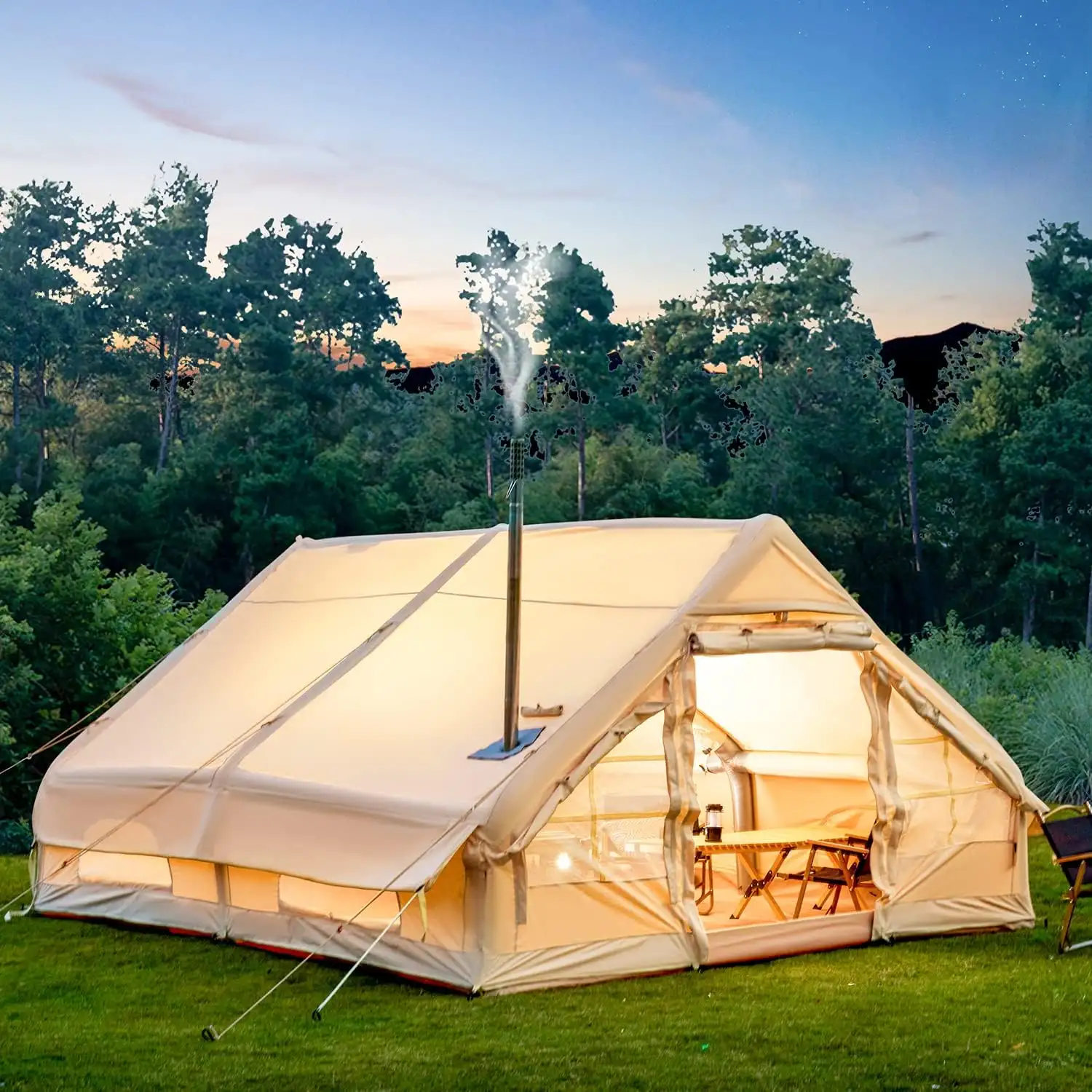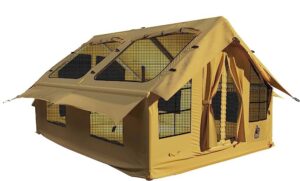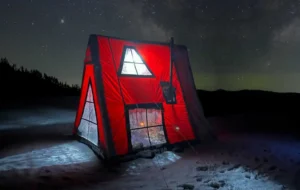Different types of blow up tent houses, such as cabin-style tents, dome tents, and tunnel tents
When it comes to blow up tent houses, you’ll find a variety of styles to choose from, each offering its own unique features and advantages. Cabin-style tents are quite popular among campers, thanks to their spaciousness and comfortable design.
These tents are typically larger in size and offer plenty of headroom, making them perfect for families or groups who value their creature comforts while out in the wilderness. With multiple rooms or dividers available, cabin-style blow up tent houses provide privacy and separation between different living areas.
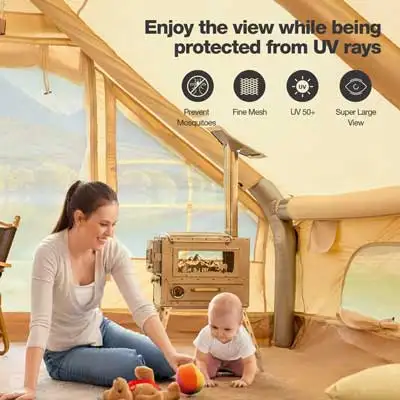
On the other hand, dome tents are a classic choice for campers looking for versatility and easy setup. The dome-shaped design makes them sturdy against wind and rain while still being lightweight and portable.
These tents often come with easy-to-use inflatable poles that make assembly a breeze. Dome-shaped blow up tent houses are great for solo campers or small groups who prioritize ease of use without sacrificing on comfort.
Tunnel tents offer a balance between space and simplicity. With their elongated shape resembling tunnels (hence the name), these tents provide ample room inside while remaining relatively compact when packed away.
Tunnel-shaped blow up tent houses are particularly popular among backpackers or those who prefer more lightweight camping gear options. So whether you’re seeking an expansive cabin-style tent for family adventures, a convenient dome tent for quick getaways, or a compact tunnel tent for solo backpacking trips, there’s surely a blow up tent house style that suits your specific needs.
Features of blow up tent houses, such as air-tight construction, waterproof fabric, and UV protection
When it comes to blow up tent houses, their features are key to ensuring a comfortable and secure camping experience. One of the standout features of these tents is their air-tight construction. Say goodbye to the hassle of traditional pole tents, because blow up tent houses are designed with inflatable beams or air poles that provide excellent stability and support.
These air-filled structures not only make setup a breeze but also eliminate the risk of bent or broken poles, ensuring your tent stays intact throughout your camping adventure. Another crucial feature to consider is the waterproof fabric used in blow up tent houses.
Nobody wants to wake up in the middle of a rainstorm with a soggy sleeping bag! That’s why these tents are crafted from high-quality materials that keep you dry even in heavy downpours.
The waterproof fabric acts as a shield against rain, preventing any water from seeping into your living space and ruining your valuable gear. This feature is particularly important when embarking on camping trips during unpredictable weather conditions or in regions known for sudden rain showers.

In addition to their air-tight construction and waterproof fabric, many blow up tent houses also offer UV protection. Spending time outdoors exposes us to harmful ultraviolet rays emitted by the sun, which can damage our skin and cause sunburns.
However, these innovative tents often incorporate UV-resistant materials into their design, acting as a shield against harmful UV radiation while still allowing you to enjoy nature’s beauty. Whether you’re lounging inside the tent during midday heat or exploring nearby hiking trails, this added layer of protection ensures you can relax without worrying about sunburns or long-term skin damage.
With their air-tight construction, waterproof fabric, and UV protection features, blow up tent houses provide campers with peace of mind and comfort in various outdoor conditions. Now that we’ve explored the essential features that contribute to an enjoyable camping experience let’s move on to discussing the benefits of opting for these convenient and spacious tents.
Benefits of blow up tent houses, such as easy setup, portability, and spaciousness
Benefits of blow up tent houses bring a whole new level of convenience to your camping experience. Let’s start with the easiest setup you can imagine. No need to struggle with confusing instructions or spend hours figuring out which pole goes where.
With blow up tent houses, you can bid farewell to the frustrating battle of assembling traditional tents. Simply unpack the tent, lay it flat on the ground, connect an air pump, and watch as it magically inflates into a sturdy shelter within minutes.
It’s like having your own portable sanctuary ready at your command! Portability is another remarkable advantage that blow up tent houses offer.
Unlike their cumbersome counterparts, these tents are designed with travel in mind. They are often made from lightweight materials that contribute to their easy portability, allowing you to carry them effortlessly on hiking trails or stow them compactly in a car trunk for road trips.
So whether you’re embarking on an adventurous backpacking expedition or planning a family camping getaway, blow up tent houses become your trusty companions throughout your journey. But wait, there’s more!
The spaciousness of blow up tent houses is truly a game-changer when it comes to camping comfort. Gone are the days of feeling cramped and confined inside traditional tents with barely enough space for your sleeping bags and gear.
Blow up tent houses provide ample room for you and your fellow campers to move around freely without bumping into each other every time someone wants to stretch or grab a snack from the cooler. And let’s not forget the extra headroom these tents offer, allowing even taller individuals to stand upright without any hunching or crouching necessary – talk about added luxury in the great outdoors!
Drawbacks of blow up tent houses, such as cost and limited durability in extreme weather conditions
Blow up tent houses, with their convenience and innovative design, certainly have their fair share of advantages. However, it would be remiss not to acknowledge some of the drawbacks that come along with these inflatable abodes.
Acme Toy Company has found that first and foremost is the cost factor. Compared to traditional tents, blow up tent houses tend to be pricier due to the advanced technology and materials used in their construction.
While they may offer superior comfort and features, this added expense can be a deterrent for budget-conscious campers. Another drawback worth considering is the limited durability of blow up tent houses in extreme weather conditions.
Although most inflatable tents are designed to withstand moderate wind and rain, they may struggle when faced with more severe elements such as high winds or heavy storms. The air-filled beams that provide structure and support can become susceptible to punctures or damage from sharp objects or strong gusts of wind.
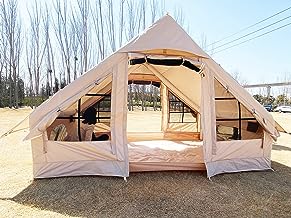
While manufacturers often provide patch kits for repairs, it’s important to exercise caution when setting up your blow up tent house in areas prone to extreme weather. That being said, it’s crucial to note that these drawbacks should not dissuade you from considering a blow up tent house altogether.
Understanding these limitations will help you make an informed decision based on your camping needs and the expected conditions during your outdoor adventures. Whether it’s investing in extra stakes and guylines for added stability during inclement weather or carefully selecting a location sheltered from strong winds, there are always ways to mitigate these potential issues while enjoying the many benefits that blow up tent houses offer.
Tips on choosing the right blow up tent house for your needs, such as considering the size of your group, the climate you’ll be camping in, and your budget
When it comes to choosing the perfect blow up tent house, you want to make sure it ticks all the boxes for your specific needs. One of the key factors to consider is the size of your group. If you’re planning a solo adventure or a cozy camping trip for two, a smaller tent house might be just what you need.
On the other hand, if you’re traveling with family or friends and want some extra wiggle room, opt for a larger tent house that can comfortably accommodate everyone. Another crucial consideration is the climate in which you’ll be camping.
If you’re heading out on a summer escapade where temperatures soar and humidity is prominent, look for a blow up tent house with excellent ventilation and mesh windows that allow for optimal airflow while keeping pesky bugs at bay. Additionally, choose a tent house made from lightweight fabric that offers UV protection to shield you from harmful sun rays during those sunny days.
Of course, budget plays an important role in any purchasing decision. When it comes to blow up tent houses, prices can vary significantly depending on factors like brand reputation, durability, and additional features.
It’s essential to set a budget before starting your search so that you have clear parameters within which to find the best option for your wallet without compromising on quality. Look out for sales or discounts on reputable brands or consider renting if budget constraints are tight but still want to experience the thrill of camping in style.
Ultimately, by considering these three primary factors – group size, climate conditions, and budget – choosing the ideal blow up tent house becomes much more manageable. So take your time researching different options and read customer reviews to ensure that the one you select meets all your requirements while providing comfort and practicality throughout your outdoor adventures
Instructions on how to set up a blow up tent house, including how to inflate the tent, stake it down, and secure the doors and windows
Setting up a blow up tent house may seem like a daunting task, but fear not, for with a little guidance, you’ll be a pro in no time. First and foremost, let’s tackle the inflation process. Most blow up tent houses come with an air pump that can usually be plugged into your car’s cigarette lighter or connected to an electrical outlet.
Simply locate the inflation valve on the tent and connect the pump securely. Once connected, start pumping that air in!
Watch in awe as your humble pile of fabric transforms into a majestic abode before your very eyes. With the tent all inflated and standing tall like a valiant knight ready for battle, it’s time to ensure it stays firmly rooted to the ground.
This is where staking comes into play. Most blow up tent houses come with sturdy metal stakes specifically designed for their unique structure.
Take these trusty stakes and drive them into the ground at a 45-degree angle. Make sure they are securely anchored to prevent any unwanted mishaps during gusty winds or rowdy camping adventures.
Now that your abode is both inflated and staked down like a fortress, it’s time to turn our attention towards securing those doors and windows. Begin by closing all zippers and Velcro fastenings on each entry point, ensuring no sneaky insects or curious critters can make their way inside uninvited.
Some tents also include additional clips or buckles to secure flaps or rainflys – don’t forget about those! Give each door and window area a gentle tug to check if they’re secure – if they budge even slightly, tighten them up until they’re snug as bug in a rug.
By following these careful instructions on how to set up your blow up tent house – inflating it with gusto, staking it down with determination, and securing its doors and windows like an expert locksmith – you’ll have created your own temporary sanctuary in nature’s embrace. So, kick back, relax, and revel in the satisfaction of a job well done as you bask in the cozy comfort of your blow up tent house.
Safety tips for using a blow up tent house, such as staking the tent down in windy conditions, preventing condensation, and keeping the tent clean and dry
Safety tips for using a blow up tent house are crucial to ensure a comfortable and secure camping experience. First and foremost, it’s essential to stake down the tent properly, especially in windy conditions. Use sturdy stakes and drive them into the ground at an angle away from the tent to maximize stability.
Additionally, consider attaching guylines or tie-downs to provide extra support and prevent your blow up tent from becoming an unintentional kite in blustery weather. Condensation can be a pesky issue when camping in any kind of tent, including blow up ones.
To minimize condensation inside your tent, make sure you have adequate ventilation by keeping windows slightly open or utilizing vents if available. Avoid cooking inside the tent as much as possible since it increases humidity levels.
If you must cook indoors due to inclement weather, use a camping stove with proper ventilation or open windows for air circulation. Keeping your blow up tent clean and dry is not only hygienic but also essential for its longevity.
Before packing it away after each camping trip, make sure it is completely dry to prevent mold and mildew growth. Wipe off any dirt or debris with a soft cloth or sponge and mild soap if necessary.
When storing your blow up tent house, ensure it is placed in a cool, dry area away from direct sunlight which can degrade the materials over time. Taking these precautions will help extend the lifespan of your blow up tent house while ensuring a safe and cozy camping experience.
Safety should always be a top priority when using blow up tent houses during outdoor adventures. By properly staking down the tent in windy conditions, preventing condensation buildup through proper ventilation techniques, and keeping the tent clean and dry during storage periods; campers can enhance their safety levels while enjoying all the benefits these innovative shelters provide – making their camping experiences memorable and worry-free
Long Story Short
Blow up tent houses provide a convenient and comfortable option for outdoor enthusiasts. Their versatility and ease of use make them an excellent choice for camping trips, backyard adventures, or even beach getaways. With various types available, such as cabin-style tents, dome tents, and tunnel tents, you can find the perfect blow up tent house to suit your needs.
One of the biggest advantages of blow up tent houses is their portability. These tents are designed to be lightweight and easy to transport.
They often come with a carrying bag that allows you to pack them up neatly and take them wherever your adventure leads. Whether you’re hiking to a remote camping spot or driving cross-country in an RV, a blow up tent house is a hassle-free option that won’t weigh you down.
Additionally, blow up tent houses offer ample space for relaxation and enjoyment. With their spacious interiors, you can comfortably sleep multiple people without feeling cramped.
This means more room for air mattresses or sleeping bags, as well as space to move around freely inside the tent. So whether you’re playing card games with friends on a rainy day or simply stretching out after a long hike, blow up tent houses provide enough room for everyone to have their own slice of comfort.
In a world where we are constantly surrounded by technology and distractions, there’s something truly invigorating about disconnecting from it all and immersing oneself in nature’s embrace. Blow up tent houses offer an opportunity to do just that – escape the hustle and bustle of daily life and find solace in the great outdoors.
As you lay under the stars at night or wake up to the sound of birds chirping in the morning, these temporary homes provide shelter while fostering a deeper connection with nature. So go ahead – embark on your next adventure with confidence knowing that your blow up tent house will be there waiting for you at the end of each exciting day.
Embrace the freedom and simplicity they offer, and let them be your gateway to unforgettable memories. Happy camping!

